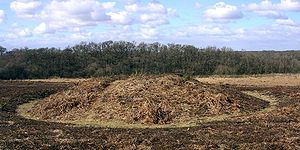
Bowl barrow
Encyclopedia

Burial
Burial is the act of placing a person or object into the ground. This is accomplished by excavating a pit or trench, placing an object in it, and covering it over.-History:...
mound or tumulus
Tumulus
A tumulus is a mound of earth and stones raised over a grave or graves. Tumuli are also known as barrows, burial mounds, Hügelgrab or kurgans, and can be found throughout much of the world. A tumulus composed largely or entirely of stones is usually referred to as a cairn...
. A barrow is a mound of earth used to cover a tomb. The bowl barrow gets its name from the fact that it looks like an upturned bowl. Related terms include cairn circle, cairn ring, howe, kerb cairn, tump or rotunda grave.
Description

Neolithic
The Neolithic Age, Era, or Period, or New Stone Age, was a period in the development of human technology, beginning about 9500 BC in some parts of the Middle East, and later in other parts of the world. It is traditionally considered as the last part of the Stone Age...
through to the Bronze Age
Bronze Age
The Bronze Age is a period characterized by the use of copper and its alloy bronze as the chief hard materials in the manufacture of some implements and weapons. Chronologically, it stands between the Stone Age and Iron Age...
in Great Britain
Great Britain
Great Britain or Britain is an island situated to the northwest of Continental Europe. It is the ninth largest island in the world, and the largest European island, as well as the largest of the British Isles...
. A bowl barrow is an approximately hemispherical mound covering one or more Inhumations or cremations
Cremation
Cremation is the process of reducing bodies to basic chemical compounds such as gasses and bone fragments. This is accomplished through high-temperature burning, vaporization and oxidation....
. Where the mound is composed entirely of stone, rather than earth, the term cairn
Cairn
Cairn is a term used mainly in the English-speaking world for a man-made pile of stones. It comes from the or . Cairns are found all over the world in uplands, on moorland, on mountaintops, near waterways and on sea cliffs, and also in barren desert and tundra areas...
replaces the word barrow. The mound may be simply a mass of earth or stone, or it may be structured by concentric rings of posts, low stone walls, or upright stone slabs. In addition, the mound may have a kerb of stones or wooden posts.
Barrows were usually built in isolation in various situations on plains, valleys and hill slopes, although the most popular sites were those on hilltop. Bowl barrows were first identified in Great Britain
Great Britain
Great Britain or Britain is an island situated to the northwest of Continental Europe. It is the ninth largest island in the world, and the largest European island, as well as the largest of the British Isles...
by John Thurnam
John Thurnam
John Thurnam was an English psychiatrist, archaeologist, and ethnologist. He was Medical Superintendent of The Retreat, the Quaker psychiatric hospital near York...
, an English psychiatrist
Psychiatrist
A psychiatrist is a physician who specializes in the diagnosis and treatment of mental disorders. All psychiatrists are trained in diagnostic evaluation and in psychotherapy...
, archaeologist, and ethnologist.
British bowl barrows

English Heritage
English Heritage . is an executive non-departmental public body of the British Government sponsored by the Department for Culture, Media and Sport...
proposed the following classification of British bowl barrows:
- Type 1: Kerbless and ditchless barrows
- Type 2: Kerbless with continuous ditch
- Type 3: Kerbless with penannular ditch
- Type 4: Kerbless with segmented ditch
- Type 5: Kerbed but ditchless
- Type 6: Kerbed with continuous ditch
- Type 7: Kerbed with pennanular ditch
- Type 8: Kerbed with segmented ditch
- Type 9: Structured but ditchless
- Type 10: Structured with continuous ditch
- Type 11: Structured with penannular ditch
- Type 12: Structured with segmented ditch
Tump
Tump is WorcestershireWorcestershire
Worcestershire is a non-metropolitan county, established in antiquity, located in the West Midlands region of England. For Eurostat purposes it is a NUTS 3 region and is one of three counties that comprise the "Herefordshire, Worcestershire and Warwickshire" NUTS 2 region...
dialect
Dialect
The term dialect is used in two distinct ways, even by linguists. One usage refers to a variety of a language that is a characteristic of a particular group of the language's speakers. The term is applied most often to regional speech patterns, but a dialect may also be defined by other factors,...
term for a small hill, such as a barrow, even a large barrow such as the Whittington Tump in the village of Whittington
Whittington, Worcestershire
Whittington is a small village near Worcester close to Junction 7 of the M5 motorway, bounded by the motorway and the main Evesham to Worcester A44 trunk road, in the District of Wychavon...
south east of Worcester, or an "unty tump" meaning mole hill (unty being Worcestershire dialect for a mole
Mole (animal)
Moles are small cylindrical mammals adapted to a subterranean lifestyle. They have velvety fur; tiny or invisible ears and eyes; and short, powerful limbs with large paws oriented for digging. The term is especially and most properly used for the true moles, those of the Talpidae family in the...
). It is related to the Welsh language
Welsh language
Welsh is a member of the Brythonic branch of the Celtic languages spoken natively in Wales, by some along the Welsh border in England, and in Y Wladfa...
term Twmpath
Twmpath
Twmpath is a Welsh word literally meaning a hump or tump, once applied to the mound or village green upon which the musicians sat and played for the community to dance. It is used today to mean a Welsh version of the barn dance or céilidh....
which was once applied to the mound or village green.

